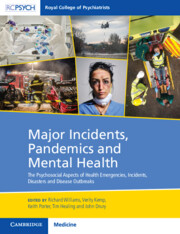 Major Incidents, Pandemics and Mental Health
Major Incidents, Pandemics and Mental Health Book contents
- Major Incidents, Pandemics and Mental Health
- Major Incidents, Pandemics and Mental Health
- Copyright page
- Dedication
- Contents
- Figures
- Tables
- Boxes
- Contributors
- Foreword by Dr Adrian James
- Foreword by Professor David Lockey
- Section 1 The Nature and Impacts of Twenty-First-Century Healthcare Emergencies
- Section 2 Clinical Aspects of Traumatic Injuries, Epidemics, and Pandemics
- Chapter 13 Advances in Pre-Hospital Care
- Chapter 14 The Changing Face of Clinical Medicine in Major Trauma
- Chapter 15 The Changing Face of Traumatic Injury
- Chapter 16 Lessons from History and the Epidemiology of Severe Epidemics and Pandemics
- Chapter 17 The Health Aspects of Epidemics and Pandemics
- Chapter 18 Challenges in Managing Epidemics and Pandemics Illustrated by Ebola and COVID-19
- Section 3 The Role of the Public in Emergencies: Survivors, Bystanders, and Volunteers
- Section 4 Responses to Meet the Mental Health Needs of People Affected by Emergencies, Major Incidents, and Pandemics
- Section 5 Sustaining and Caring for Staff During Emergencies
- Section 6 Designing, Leading, and Managing Responses to Emergencies and Pandemics
- Section 7 Key Lessons for the Way Forward
- A Glossary of Selected Key Terms Used in This Book
- Index
- References
Chapter 16 - Lessons from History and the Epidemiology of Severe Epidemics and Pandemics
Plague, Cholera, Influenza, Viral Haemorrhagic Fevers, and Coronaviruses
from Section 2 - Clinical Aspects of Traumatic Injuries, Epidemics, and Pandemics
Published online by Cambridge University Press: 11 January 2024
- Major Incidents, Pandemics and Mental Health
- Major Incidents, Pandemics and Mental Health
- Copyright page
- Dedication
- Contents
- Figures
- Tables
- Boxes
- Contributors
- Foreword by Dr Adrian James
- Foreword by Professor David Lockey
- Section 1 The Nature and Impacts of Twenty-First-Century Healthcare Emergencies
- Section 2 Clinical Aspects of Traumatic Injuries, Epidemics, and Pandemics
- Chapter 13 Advances in Pre-Hospital Care
- Chapter 14 The Changing Face of Clinical Medicine in Major Trauma
- Chapter 15 The Changing Face of Traumatic Injury
- Chapter 16 Lessons from History and the Epidemiology of Severe Epidemics and Pandemics
- Chapter 17 The Health Aspects of Epidemics and Pandemics
- Chapter 18 Challenges in Managing Epidemics and Pandemics Illustrated by Ebola and COVID-19
- Section 3 The Role of the Public in Emergencies: Survivors, Bystanders, and Volunteers
- Section 4 Responses to Meet the Mental Health Needs of People Affected by Emergencies, Major Incidents, and Pandemics
- Section 5 Sustaining and Caring for Staff During Emergencies
- Section 6 Designing, Leading, and Managing Responses to Emergencies and Pandemics
- Section 7 Key Lessons for the Way Forward
- A Glossary of Selected Key Terms Used in This Book
- Index
- References
Summary
Pandemics and epidemics have affected human populations throughout recorded history. Larger human communities make it possible for epidemics to occur, and also promote maintaining infections in endemic form. Regardless of the organisms involved and the nature of the illness caused, certain themes are common to all in terms of the impacts and outcomes of the outbreaks in health, social, and political terms, and the measures used in attempts to control these events. In some instances, these measures have exerted some beneficial effects by changing the rate of spread of outbreaks, although not necessarily the numbers affected. it is only recently, with the advent of vaccination, that it has it become possible to effectively reduce the impacts of pandemics. Given the frequency with which people are exposed to novel infections and the speed with which some organisms can mutate, the need for readiness to combat pandemics on a worldwide basis is paramount.
Keywords
- Type
- Chapter
- Information
- Major Incidents, Pandemics and Mental HealthThe Psychosocial Aspects of Health Emergencies, Incidents, Disasters and Disease Outbreaks, pp. 107 - 117Publisher: Cambridge University PressPrint publication year: 2024
References
- 2
- Cited by
